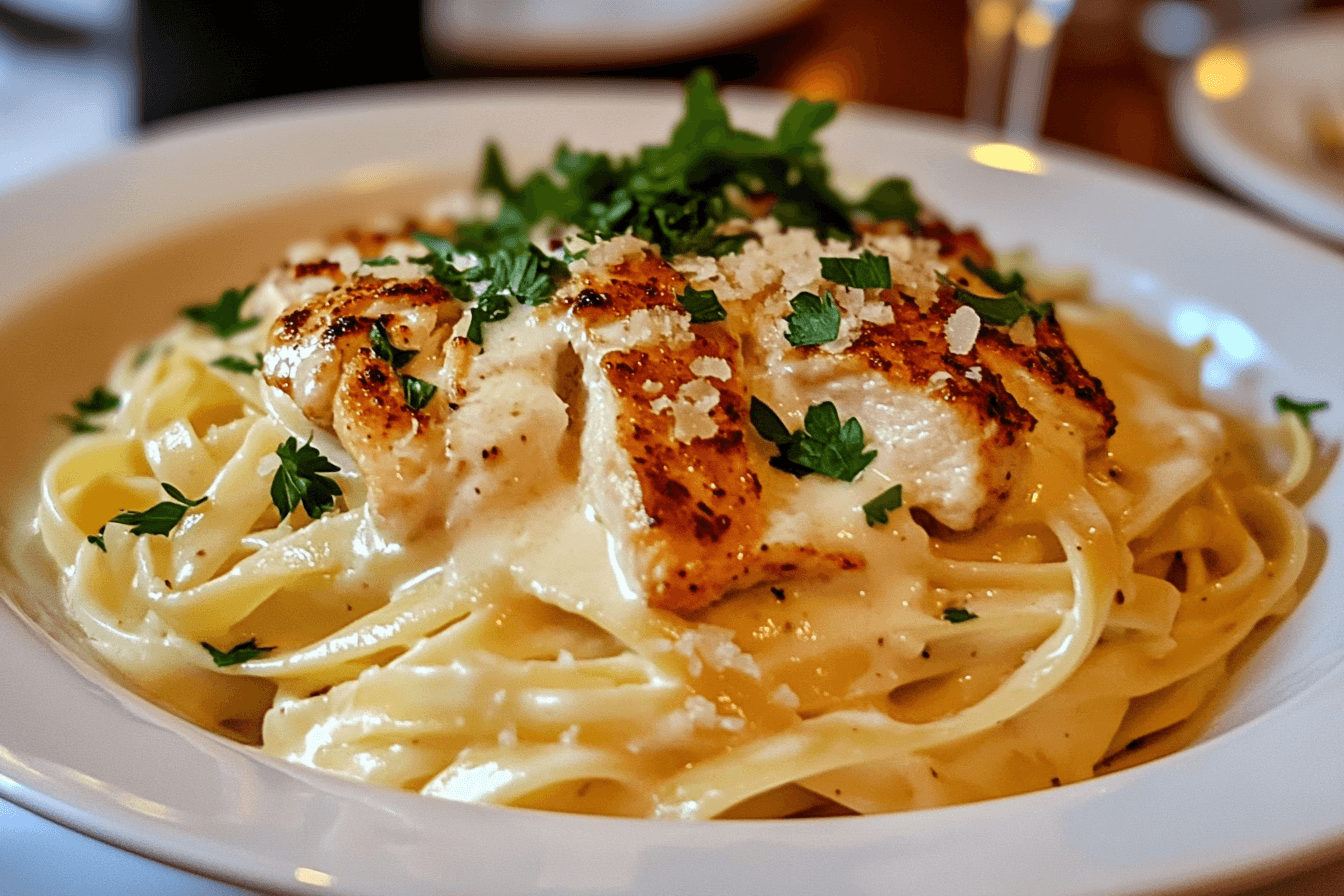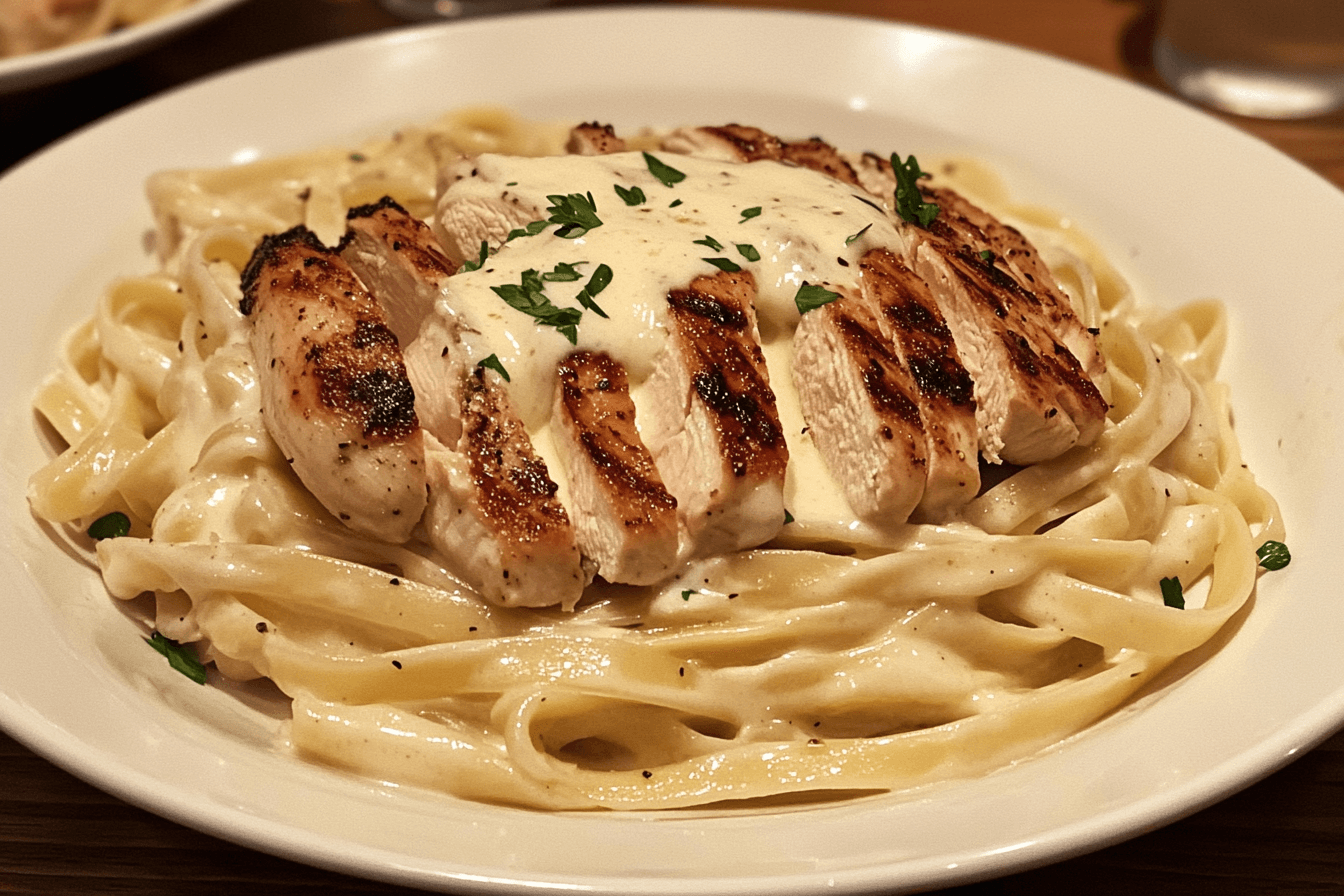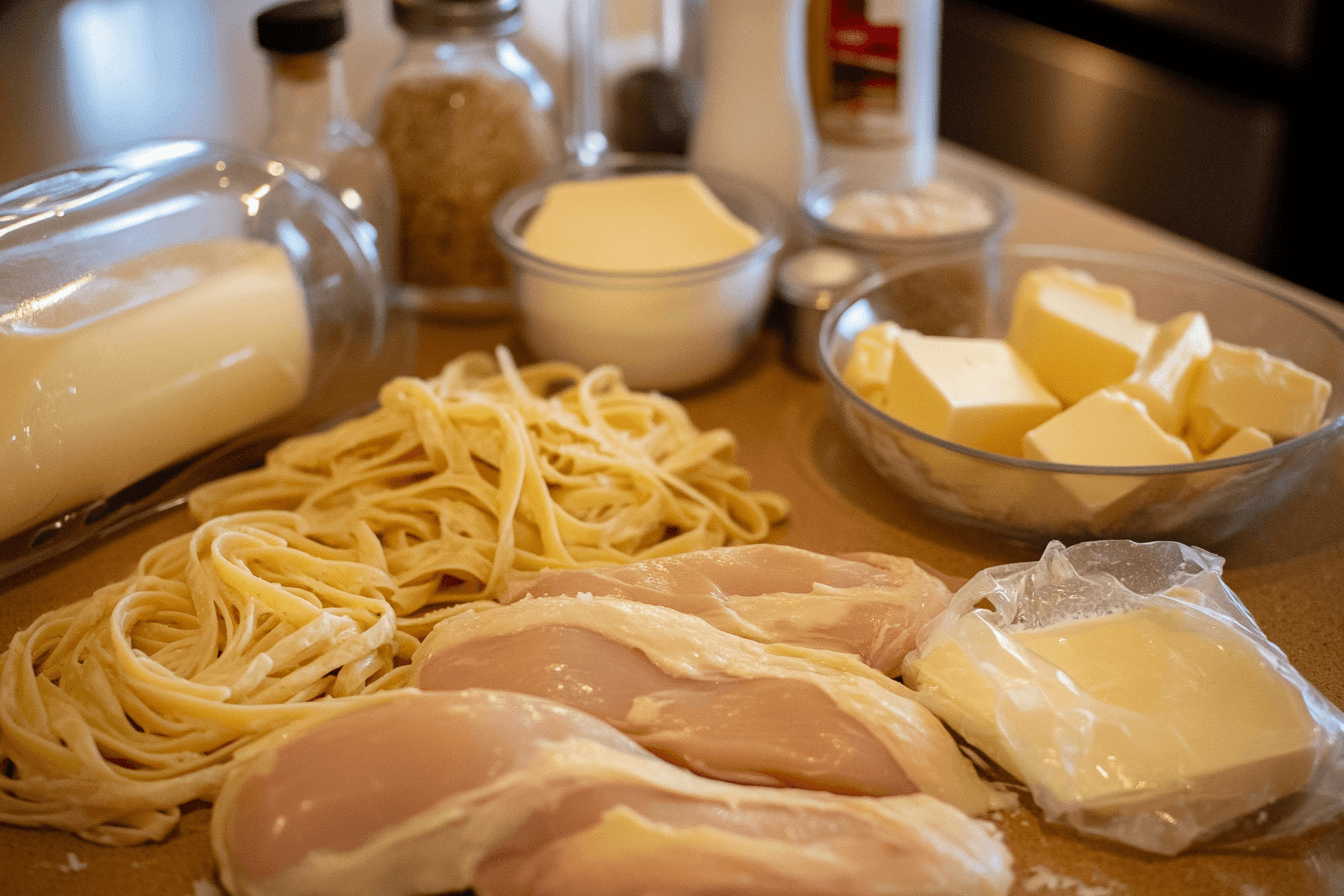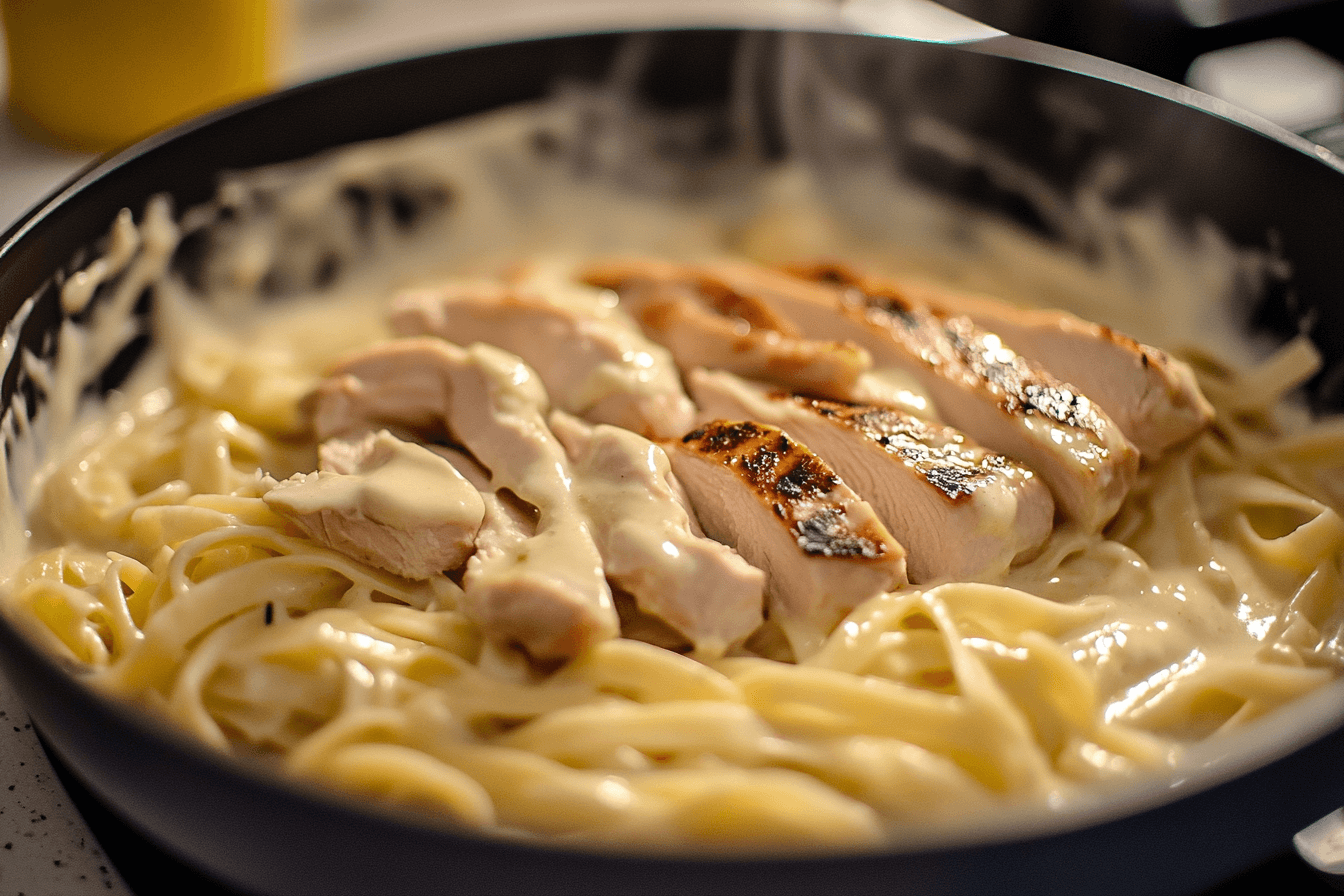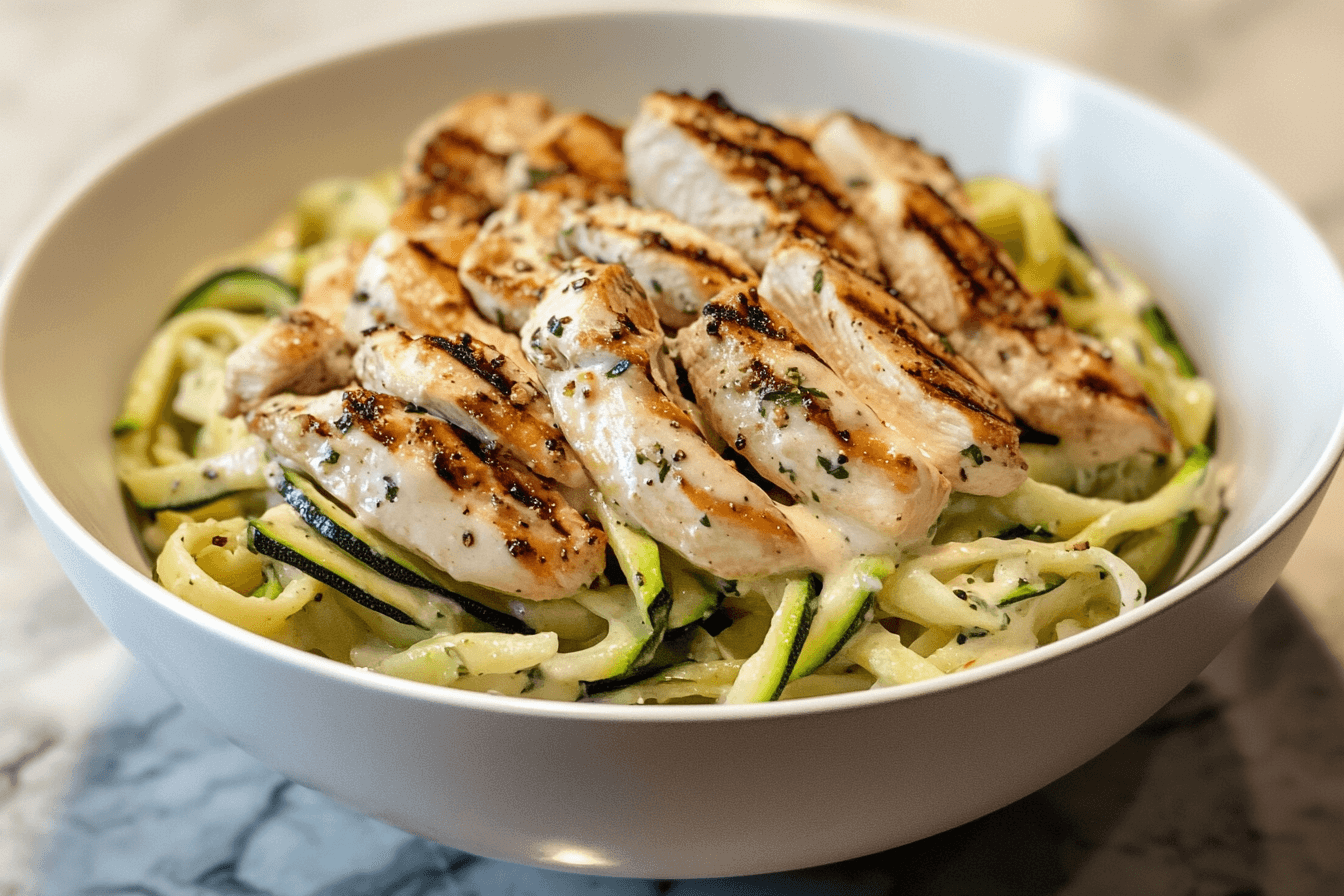Introduction to Chicken Fettuccine Alfredo
Chicken Fettuccine Alfredo—an iconic dish that seamlessly blends comfort, indulgence, and timeless flavors. This creamy, velvety pasta has earned its place in kitchens around the world, becoming a favorite for family dinners and special occasions alike. At the heart of Chicken Fettuccine Alfredo lies a rich, smooth sauce that envelops tender fettuccine noodles and perfectly cooked chicken. But this dish is more than just a recipe—it’s an experience. It brings together rich Italian culinary tradition and modern adaptations to create a meal that is universally adored. Whether you’re looking to master a classic or make your own variation, this guide provides everything you need to know, from its origins to preparing it to perfection. Let’s begin by exploring what makes Chicken Fettuccine Alfredo such a revered dish.
What is Chicken Fettuccine Alfredo?
The Origins of Chicken Fettuccine Alfredo
Chicken Fettuccine Alfredo is often considered a quintessential Italian-American dish, though its roots are not as deep in Italy as one might think. The dish’s core components—fettuccine pasta and a rich cream sauce—were first popularized by Alfredo di Lelio in Rome in the early 20th century. Alfredo’s original creation was a simple blend of fettuccine, butter, and Parmesan cheese, which he served to his wife to help her recover from an illness. The dish became a sensation after it was served to Hollywood stars in the 1920s, eventually making its way across the Atlantic.
While the traditional Alfredo sauce was originally just butter and cheese, the modern version of Chicken Fettuccine Alfredo has evolved to include heavy cream and a variety of seasonings. The addition of chicken provides extra protein and flavor, making it a heartier meal. Over time, this variation gained popularity, particularly in the United States, where it became a staple in Italian-American cuisine.
Why Chicken Fettuccine Alfredo is So Popular
The widespread popularity of Chicken Fettuccine Alfredo can be attributed to several key factors. First, its creamy, rich sauce offers an indulgent flavor experience that many find irresistible. The Alfredo sauce—made from butter, cream, and Parmesan—creates a velvety texture that complements the fettuccine, making each bite deeply satisfying. The addition of chicken adds a savory, hearty element that balances the richness of the sauce.
Furthermore, Chicken Fettuccine Alfredo is a dish that lends itself well to adaptation. It can easily be customized to accommodate a variety of tastes and dietary preferences. For instance, vegetables can be added to the dish to introduce fresh textures and additional nutrients. The sauce itself can be adjusted with different herbs and spices to enhance its flavor, allowing chefs to put their own spin on this classic. Additionally, for those with dietary restrictions, the dish is versatile enough to be made gluten-free, dairy-free, or even vegan, without losing the essential comfort and satisfaction it is known for.
This flexibility, combined with its rich, indulgent taste, ensures that Chicken Fettuccine Alfredo remains a beloved and versatile dish in kitchens across the globe.
Key Ingredients for Chicken Fettuccine Alfredo
Essential Ingredients for the Perfect Chicken Fettuccine Alfredo
To achieve the perfect Chicken Fettuccine Alfredo, it’s essential to use high-quality ingredients that will enhance the flavor and texture of the dish. While the recipe itself is simple, the right ingredients make all the difference.
-
Fettuccine Pasta: The backbone of the dish, fettuccine is a broad, flat pasta that soaks up the rich Alfredo sauce beautifully. While you can substitute with other types of pasta, fettuccine is traditionally used because its texture complements the creamy sauce perfectly.
-
Chicken: Boneless, skinless chicken breasts are the most common choice for Chicken Fettuccine Alfredo, as they are lean and easy to cook. They can be seasoned and pan-seared to golden perfection, providing the dish with juicy, flavorful protein.
-
Heavy Cream: The key ingredient in creating the creamy, rich sauce. Heavy cream ensures that the sauce is smooth and indulgent, helping to create that velvety texture that defines the dish.
-
Parmesan Cheese: Authentic Parmesan is a must-have for the Alfredo sauce. Freshly grated Parmesan melts perfectly into the cream, lending a nutty, salty flavor that is essential to the dish. It’s crucial to use high-quality Parmesan to achieve the best results.
-
Butter: Butter contributes to the richness of the sauce. It adds a silky smoothness and depth of flavor that enhances the overall creaminess of the dish. It’s best to use unsalted butter to control the salt content of the sauce.
-
Garlic: Garlic adds a wonderful aromatic element to the sauce, balancing the richness of the cream and butter with its savory, slightly pungent flavor. Fresh garlic, sautéed just until fragrant, provides the perfect base for the sauce.
-
Seasonings: While the simplicity of the ingredients is key to this dish, a few well-chosen seasonings can elevate the flavor. Salt, black pepper, and freshly grated nutmeg are commonly used to add depth to the Alfredo sauce. Some recipes also call for a pinch of Italian seasoning or fresh parsley for garnish.
How to Choose the Right Ingredients for Maximum Flavor
Selecting the best ingredients is crucial to making a Chicken Fettuccine Alfredo that’s bursting with flavor. Here are a few tips for choosing ingredients that will help you make the best version of this dish:
-
Fresh vs. Pre-Packaged Fettuccine: Fresh fettuccine will provide a softer, more delicate texture compared to dried pasta. If you have the time, consider using fresh pasta, but if you’re short on time, high-quality dried fettuccine works just as well.
-
Boneless Skinless Chicken Breasts: Opt for chicken breasts that are firm and pink in color, with no visible signs of bruising or discoloration. If you prefer darker meat, chicken thighs can be used for a richer flavor, though they may require slightly longer cooking times.
-
Authentic Parmesan: When it comes to Parmesan, the best flavor comes from freshly grated cheese rather than pre-grated varieties. A wedge of authentic Parmigiano-Reggiano will offer the most intense, nutty flavor that can’t be matched by the pre-packaged options.
-
High-Quality Cream: Choose heavy cream with a higher fat content (around 36-40%) for the creamiest, most luxurious texture. Avoid half-and-half or lighter creams, as they won’t provide the same richness.
By paying attention to the quality of each ingredient, you can ensure that your Chicken Fettuccine Alfredo is as flavorful and satisfying as possible. A few simple upgrades—like using fresh pasta and high-quality Parmesan—can elevate the dish and make it truly exceptional.
Step-by-Step Guide to Making Chicken Fettuccine Alfredo
Step 1: Preparing the Chicken
The chicken is the star of this dish, so it’s important to prepare it correctly to ensure it’s juicy and flavorful. Start by seasoning the chicken breasts generously with salt, black pepper, and any other spices you prefer, such as garlic powder or paprika. These simple seasonings will enhance the natural flavor of the chicken without overpowering the creamy Alfredo sauce.
Next, heat a large skillet over medium-high heat and add a tablespoon of olive oil or butter. Once the oil is hot, add the chicken breasts to the pan. Cook them for about 6-7 minutes on each side, depending on thickness, until they are golden brown and the internal temperature reaches 165°F (75°C). The key is to avoid overcooking the chicken, as it can become dry. When done, remove the chicken from the pan and let it rest for a few minutes before slicing it into strips or cubes. Set the chicken aside while you prepare the pasta and sauce.
Step 2: Cooking the Fettuccine Pasta
While the chicken is cooking, bring a large pot of salted water to a boil. Add the fettuccine pasta and cook according to the package instructions, usually for around 8-10 minutes, until the pasta is al dente. The goal is to cook the pasta until it’s firm to the bite, so it holds up well when tossed with the sauce. Once the pasta is ready, reserve about 1 cup of pasta water (this will help loosen the sauce later if needed) and drain the rest. Set the cooked fettuccine aside.
A guide to How to cook Pasta correctly!
Step 3: Making the Alfredo Sauce
Now it’s time to make the rich and creamy Alfredo sauce. In the same skillet you used to cook the chicken, melt 2 tablespoons of butter over medium heat. Add 3-4 cloves of minced garlic and sauté for about 30 seconds, just until fragrant. Be careful not to burn the garlic, as it can turn bitter.
Once the garlic is fragrant, pour in 1 cup of heavy cream and bring it to a gentle simmer. Allow the cream to cook for 2-3 minutes, stirring occasionally. As the cream simmers, it will thicken slightly. At this point, add 1 cup of freshly grated Parmesan cheese to the pan. Stir continuously to incorporate the cheese into the sauce, ensuring it melts smoothly. If the sauce becomes too thick, you can gradually add some reserved pasta water to achieve the desired consistency.
Taste the sauce and season with salt, pepper, and a pinch of freshly grated nutmeg, which adds a subtle warmth to the dish. Stir everything together until the sauce is silky and smooth.
Step 4: Combining the Chicken, Pasta, and Sauce
Now that your chicken, pasta, and sauce are ready, it’s time to combine everything into one delicious dish. Add the drained fettuccine pasta into the Alfredo sauce, tossing to coat the noodles evenly. Then, gently fold in the sliced chicken, making sure each piece is coated with the creamy sauce. If the sauce needs thinning, add a little more reserved pasta water, stirring until the pasta and sauce are well combined and creamy.
Once everything is combined, give the dish a final taste and adjust the seasonings if necessary. Garnish with freshly chopped parsley or additional grated Parmesan for an extra burst of flavor and color.
Serve your Chicken Fettuccine Alfredo immediately while it’s still warm and creamy, and enjoy the delightful comfort of this rich, indulgent dish.
Variations of Chicken Fettuccine Alfredo
Healthy Versions of Chicken Fettuccine Alfredo
Chicken Fettuccine Alfredo is undeniably delicious, but for those seeking a healthier take on this creamy classic, there are several substitutions that can help lighten the dish while still maintaining its indulgent flavors.
One of the simplest ways to create a healthier version is by swapping heavy cream for lighter ingredients. For example, you can substitute heavy cream with a combination of half-and-half or even milk and a small amount of cream cheese to help thicken the sauce while keeping the richness intact. If you’re looking for an even lighter option, Greek yogurt can be used as a substitute for cream to create a creamy texture with less fat and more protein. The result is a sauce that’s both creamy and tangy, with a lighter feel on the palate.
Additionally, consider using zucchini noodles or whole wheat fettuccine as a pasta alternative. Zucchini noodles, also known as “zoodles,” are a great low-carb option that still provides the satisfying texture of pasta. Whole wheat fettuccine, on the other hand, offers more fiber and a slightly nutty flavor, which can complement the rich Alfredo sauce beautifully. You could also try adding vegetables like broccoli, spinach, or bell peppers to introduce more nutrients and flavor, making the dish not only lighter but more vibrant.
For the chicken, try grilling or baking the chicken breasts rather than pan-searing them with butter or oil. This will cut down on the amount of added fat while still giving you tender, juicy chicken. If you’re looking for a protein alternative, grilled shrimp or tofu can also work beautifully in place of the chicken, adding a slightly different flavor and texture to the dish.
These simple adjustments can help transform Chicken Fettuccine Alfredo into a dish that’s both delicious and better for your health, without compromising on taste.
Vegetarian and Vegan Chicken Fettuccine Alfredo
For those following a vegetarian or vegan lifestyle, it’s still very possible to enjoy the creamy comfort of Chicken Fettuccine Alfredo with a few smart substitutions. With the right ingredients, you can recreate the beloved flavors without any animal products.
To start, instead of chicken, use tofu, tempeh, or even portobello mushrooms for a meaty texture. Tofu can be sautéed and seasoned to mimic the flavors of chicken, while tempeh offers a nuttier, firmer bite. Portobello mushrooms, with their rich, earthy flavor, are a great option that complements the creamy Alfredo sauce.
For the sauce, ditch the dairy and heavy cream by using coconut milk or cashew cream. Coconut milk has a naturally creamy texture and a subtle sweetness that pairs nicely with the savory components of the dish. Alternatively, cashew cream, which is made by blending soaked cashews with water, creates a rich, creamy base that mimics the texture of dairy-based Alfredo sauce.
To further enrich the flavor of the sauce, add nutritional yeast. This ingredient adds a cheesy, umami flavor, which is perfect for vegan versions of Alfredo. Another option is to use a vegan Parmesan cheese made from nuts, such as almonds or cashews, which can be sprinkled on top as a garnish to add a bit of crunch and flavor.
Lastly, choose a pasta that fits your dietary needs. There are a variety of gluten-free and grain-free pasta options available, such as those made from brown rice, chickpeas, or lentils, which offer a healthy and tasty alternative to traditional pasta.
With these thoughtful adjustments, you can easily create a vegetarian or vegan version of Chicken Fettuccine Alfredo that’s every bit as satisfying and flavorful as the classic recipe.
Tips for Perfecting Chicken Fettuccine Alfredo
Troubleshooting Common Issues with Alfredo Sauce
Alfredo sauce can be tricky to perfect, but with a few helpful tips, you can avoid common pitfalls and ensure your sauce is smooth and creamy every time.
One of the most common issues is when the sauce separates or becomes greasy. This often happens if the sauce is cooked over too high of a heat, causing the butter and cream to separate. To prevent this, always cook your Alfredo sauce over low to medium heat. If the sauce begins to separate, try whisking in a small amount of reserved pasta water or a bit more cream to help bring it back together. Adding a teaspoon of cornstarch mixed with water can also help stabilize the sauce.
Another challenge is getting the right consistency. If your sauce turns out too thick, it can make the dish feel heavy and clumpy. On the flip side, if it’s too thin, the sauce won’t cling to the pasta, leaving you with a watery dish. To fix this, simply adjust the thickness by adding more cream or using some of the pasta water, which is rich in starch and will help thicken the sauce without losing its creamy texture.
If your Alfredo sauce tastes too bland, this could be due to under-seasoning. A pinch of salt and freshly ground black pepper should always be added, but don’t forget to add a dash of freshly grated nutmeg. Nutmeg adds a subtle warmth to the sauce and enhances the flavor profile without overpowering the dish. You can also experiment with adding garlic powder, a little lemon zest, or even a dash of cayenne pepper for some heat, depending on your personal taste preferences.
How to Make Chicken Fettuccine Alfredo Ahead of Time
One of the greatest things about Chicken Fettuccine Alfredo is that it can be made ahead of time, making it perfect for meal prep or a stress-free dinner party.
To prepare the dish ahead of time, simply follow the recipe as usual, but don’t combine the pasta and sauce until you’re ready to serve. Instead, store the pasta and Alfredo sauce separately in airtight containers in the refrigerator. The chicken can also be pre-cooked and stored in the same manner. When you’re ready to eat, reheat the sauce gently over low heat, adding a splash of reserved pasta water or extra cream to loosen it up. Then, add the pasta and chicken, toss everything together, and serve.
If you’re planning to freeze the dish, be sure to store the sauce and pasta separately. Freezing the sauce might cause it to change in texture, so it’s important to reheat it slowly and add more liquid as needed to restore the creaminess. The chicken can also be frozen, but like the sauce, it should be reheated thoroughly before serving.
For best results, avoid assembling the entire dish and freezing it as one; this can cause the sauce to lose its creamy consistency. Instead, freeze the components separately and assemble just before serving.
Making Chicken Fettuccine Alfredo ahead of time is a convenient way to enjoy this decadent dish without the hassle of preparing everything from scratch on the day of your meal. Whether for a quick weeknight dinner or a make-ahead meal for entertaining, this method ensures you’ll have a delicious, stress-free meal at your fingertips.
Frequently Asked Questions (FAQs)
What is the difference between Fettuccine Alfredo and Chicken Alfredo?
The difference lies in the addition of chicken. Fettuccine Alfredo is made with pasta and a creamy Alfredo sauce, while Chicken Alfredo includes seasoned, cooked chicken, adding protein and making the dish heartier.
Can I make Chicken Fettuccine Alfredo without heavy cream?
Yes, you can use lighter alternatives like half-and-half, milk, or cashew cream. For a dairy-free option, try coconut milk or a non-dairy cream. You can also explore healthier pasta choices like chickpea pasta for a better alternative: Why Chickpea Pasta is Better for You.
What can I substitute for Parmesan cheese in Alfredo sauce?
You can use nutritional yeast, vegan Parmesan, or Grana Padano as a substitute. These options provide a cheesy flavor without the dairy.
How do you make Chicken Fettuccine Alfredo healthier?
Use lighter cream options like half-and-half or cashew cream, swap regular pasta for whole wheat or zucchini noodles, and add veggies like broccoli or spinach to boost the nutritional value.
Can I add vegetables to Chicken Fettuccine Alfredo?
Yes, vegetables like broccoli, spinach, and mushrooms are great additions that add color, texture, and nutrients while balancing the richness of the sauce.
How do you store leftover Chicken Fettuccine Alfredo?
Store leftovers in an airtight container in the fridge for up to 3-4 days. Reheat gently on the stovetop with a splash of cream or pasta water to restore the sauce’s texture.
Conclusion
Chicken Fettuccine Alfredo is a versatile and indulgent dish that can easily be adapted to suit various dietary preferences. Whether you stick to the classic version or experiment with healthier or vegan alternatives, the rich and creamy sauce combined with tender chicken and pasta remains a comforting favorite. With simple tweaks, you can enjoy this dish without compromising on flavor, making it perfect for any occasion. So, go ahead, enjoy the deliciousness of Chicken Fettuccine Alfredo in whatever way suits your taste and lifestyle best.

